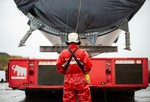07/22/2010
USA - Study explores role of grid technologies in growth of U.S. wind energy
A recent report, Business Strategy: Optimizing Transmission for Wind Integration examines the role of key transmission technologies essential for the rapid growth of the U.S. wind energy market. The report (Document # EI223579, June 2010) from IDC Energy Insights, Framingham, Mass., (idc.com) describes the impact of current transmission constraints on existing and planned wind farms and the challenges encountered to proposals of new transmission lines.
“Wind-based electricity generation has enjoyed rapid growth in the U.S. over the past 10 years, driven by state-level renewable portfolio standards and wind’s current status as the least cost, most scalable renewable energy option,” says IDC Energy Insights Research Manager Jay Holman. “New wind farms must be located in areas with excellent wind resources and, unfortunately, these areas are often far from load centers and have weak transmission infrastructure.”
According to the IDC Energy Insights study, this creates a well documented need for additional transmission capacity, which has been difficult to satisfy due to planning and permitting hurdles that can cause endless delays and cost escalations for new transmission projects.
However, IDC Energy Insights research indicates it is not always necessary to build new transmission lines to add transmission capacity. Technologies exist that allow an increase in transmission capacity that causes little or no visible change to the existing transmission infrastructure. Even in situations where new transmission lines are required, technologies are available that can minimize their footprint, helping to stimulate planning and permitting. While no single technology will solve all transmission related challenges, together these technologies will play an important role in increasing the penetration of renewables – wind in particular – on the grid. The technologies cited by the report include:
• Dynamic line rating
• High-temperature, low-sag conductors
• Voltage uprating
• Ac-to dc conversion
• Flexible ac transmission equipment
• High-voltage dc equipment
• Superconducting conductors
“The costs that transmission constraints have imposed on the energy industry through wind curtailment and wind project delays, cancellations, and size reductions have led to increased focus on technologies that can quickly and economically increase transmission capacity while helping to alleviate challenges associated with the planning and permitting process,” says Holman.
The IDC Energy Insights study includes an overview of transmission technologies that offer solutions to the challenges along with examples and an analysis of the strengths and weaknesses of each approach. Finally, the report draws conclusions and makes recommendations for industry stakeholders who want to take full advantage of existing and planned transmission technologies.
For more information please contact Trevor Sievert at ts@windfair.net
“Wind-based electricity generation has enjoyed rapid growth in the U.S. over the past 10 years, driven by state-level renewable portfolio standards and wind’s current status as the least cost, most scalable renewable energy option,” says IDC Energy Insights Research Manager Jay Holman. “New wind farms must be located in areas with excellent wind resources and, unfortunately, these areas are often far from load centers and have weak transmission infrastructure.”
According to the IDC Energy Insights study, this creates a well documented need for additional transmission capacity, which has been difficult to satisfy due to planning and permitting hurdles that can cause endless delays and cost escalations for new transmission projects.
However, IDC Energy Insights research indicates it is not always necessary to build new transmission lines to add transmission capacity. Technologies exist that allow an increase in transmission capacity that causes little or no visible change to the existing transmission infrastructure. Even in situations where new transmission lines are required, technologies are available that can minimize their footprint, helping to stimulate planning and permitting. While no single technology will solve all transmission related challenges, together these technologies will play an important role in increasing the penetration of renewables – wind in particular – on the grid. The technologies cited by the report include:
• Dynamic line rating
• High-temperature, low-sag conductors
• Voltage uprating
• Ac-to dc conversion
• Flexible ac transmission equipment
• High-voltage dc equipment
• Superconducting conductors
“The costs that transmission constraints have imposed on the energy industry through wind curtailment and wind project delays, cancellations, and size reductions have led to increased focus on technologies that can quickly and economically increase transmission capacity while helping to alleviate challenges associated with the planning and permitting process,” says Holman.
The IDC Energy Insights study includes an overview of transmission technologies that offer solutions to the challenges along with examples and an analysis of the strengths and weaknesses of each approach. Finally, the report draws conclusions and makes recommendations for industry stakeholders who want to take full advantage of existing and planned transmission technologies.
For more information please contact Trevor Sievert at ts@windfair.net
- Source:
- Online Editorial, www.windfair.net
- Author:
- Posted by Trevor Sievert, Online Editorial Journalist
- Email:
- ts@windfair.net
- Link:
- www.windfair.net/...
- Keywords:
- Wind energy, wind power, wind turbine, wind mill, offshore, onshore, wind farm, renewable energy








